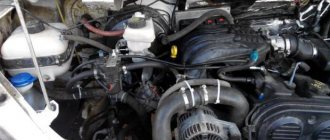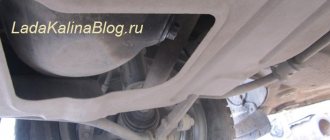At the beginning of 2021, AVTOVAZ showed a new 1.8-liter engine with a power of 122 hp. with index VAZ-21179. At first this engine was installed on the Lada XRAY, and then it appeared under the hood of the Lada Vesta sedan. Let's consider its characteristics, features and reviews from the owners of this power unit.
GC
- Throttle valve - without mechanical drive.
- Additional oil channels are made in the cylinder head for the phase regulator. Lightweight valves are from Mahle.
- The catcollector is supplied by the Russian company Ecoalliance. The diameter of the input channels has been increased to 39 mm. The oxygen sensor bears the Bosch emblem.
- The crankshaft has an increased crank radius.
- The working volume of the cylinders has increased due to the larger piston stroke.
- A reliable high-performance water pump is purchased from the Korean company GMB.
- For the first time, a VAZ engine has an imported GMB oil pump with increased performance.
- A new automatic timing belt tensioner was used - with two rollers, from the German company INA.
- Lightweight connecting rod and piston group - manufactured by Federal Mogul.
- The fuel rail is from Continental. The injectors have increased productivity, the spray pattern is optimized for the working process of the new engine.
The 1.8 liter engine is not very different in appearance from the current VAZ sixteen-valve engines.
But this is a new motor, and of our own design. Main parameters:
- working volume - 1774 cm³
- power - 122 hp
- torque - 170 Nm at 3750 rpm.
The new motor is designed for Vesta, XRAY and Largus models. There is an additional area on the cylinder block for applying the serial number. It is clearly visible when the power unit is installed longitudinally in the engine compartment. Got the hint? There is no official information yet, but it is easy to guess that we are talking about Niva. The cylinder block is unified with that used on the current 1.6-liter VAZ-21126, -21127 and -21129 engines. Same height and same diameter of the cylinders. The differences are in the additional channels of the lubrication system, which ensure the operation of the phase regulator, and additional channels of the cooling system.
Technical characteristics of the VAZ 21179 engine
Comparison table of Lada Vesta and XRAY engines:
| Engine model | VAZ 21129 | HR16DE/H4M | VAZ 21179 |
| Symbol | 1.6 l, 16 cl | 1.8 l, 16 cl | |
| Type | Petrol, 4-cylinder, in-line | ||
| Working volume, l (cm 3) | 1,6 (1596) | 1,6 (1596) | 1,8 (1774) |
| Cylinder diameter, mm | 82 | 78 | 82 |
| Piston stroke, mm | 75,6 | 83,6 | 84 |
| Compression ratio | 10,5 | 10,7 | 10,3 |
| Number of camshafts | 2 | ||
| Number of valves per cylinder | 4 | ||
| Timing drive type | Toothed belt | Chain | Toothed belt |
| When the timing belt breaks | Valve bend | – | Valve bend |
| Rated net power, kW/hp. (at crankshaft rotation speed, min -1) | 75/106 (5500) | 81/110 (5800) | 90/122 (6000) |
| Maximum net torque, Nm (at crankshaft speed, min -1) | 148/4200 | 150/4000 | 170/3750 |
| Minimum crankshaft rotation speed at idle, min -1 | 840 | 675-725 | 840 |
| Weight, kg | 92,5 | 105,4 | 109,7 |
| Ignition system | Electronic, contactless, microprocessor controlled | ||
| Cylinder operating order | 1-3-4-2 | ||
| Supply system | Multiport fuel injection | ||
| Fuel | Unleaded gasoline with octane number 95* | ||
| Availability of neutralizer | Eat | ||
| Toxicity standards | Euro 5 | ||
| Oil consumption depending on fuel consumed, % | 0,3 | 0,3 | |
| Oil volume in the lubrication system of an engine with a cast (light-alloy) sump (manual transmission), l | 4,1 | 4,7 | 4,1 |
| Engine oil quality class according to API* | SL, SM or SN | ||
| Engine oil viscosity grade according to SAE* | see motor oil | see motor oil | see motor oil |
| Resource, km | 200 000 | ||
GC1–9
Throttle valve - without mechanical drive.
The motor meets Euro-5 requirements. Throttle valve - without mechanical drive. The motor meets Euro-5 requirements.
The working volume was increased by increasing the piston stroke from 75.6 to 84.0 mm. The crankshaft has an increased crank radius and other counterweights. To reduce friction losses, the diameters of the crankpin journals were reduced from 47.8 to 43 mm. The oil channels have become different - so-called neck-to-neck drilling reduces production costs, and fewer chips and dirt remain in the oil channels. At the end of the shaft there is a mark for the classes of the main and connecting rod journals for precise adjustment of the liners by diameter, that is, for selective assembly.
Maintenance
The actual service life of the internal combustion engine is still unknown due to the short service life of the first cars rolling off the assembly line in 2021. However, to increase it, engine 21179 should be serviced according to the regulations below:
- 10,000 km means changing the filter/oil;
- twice as long, the alternator belt runs 30,000 km;
- after 45,000 km, change hoses/fittings and antifreeze;
- spark plugs and batteries are enough for 60,000 km;
- About 180,000 the original timing belt passes.
For 2021, the internal combustion engine device is considered the most advanced in the AvtoVAZ manufacturer’s line. In practice, his project had been considered since 2006, but was constantly postponed until the technical, economic and market situation in the Russian Federation finally developed favorably. That is, AvtoVAZ in this project prioritized the power output of the engine, and not economical fuel consumption, as was usually the case before.
GC1–8
Additional oil channels are made in the cylinder head for the phase regulator.
Lightweight valves are from Mahle. Additional oil channels are made in the cylinder head for the phase regulator. Lightweight valves are from Mahle.
The cylinder block and crankshaft are produced at AVTOVAZ. But the lightweight connecting rod and piston group is purchased from Federal Mogul - Vostok (Tolyatti). A graphite coating is applied to the piston skirt; the shape of the skirt is adjusted to increase the contact patch. The rings are the same as on other engines in the family, only the oil scraper rings are chrome plated. The height of the heat zone has been increased by 1.3 mm, and now the so-called compression height is 26.7 mm versus 25.4 mm for 1.6 liter engines. The price for increasing the piston stroke at the same block height is reducing the length of the connecting rod from 133 to 128 mm. The lower connecting rod head is made using the so-called breaking technology - like the current 1.6-liter engines.
Technical characteristics of the VAZ 21179 1.8 16kl engine
| Type | in-line |
| Number of cylinders | 4 |
| Number of valves | 16 |
| Exact volume | 1774 cm³ |
| Cylinder diameter | 82 mm |
| Piston stroke | 84 mm |
| Supply system | injector |
| Power | 122 hp |
| Torque | 170 Nm |
| Compression ratio | 10.3 |
| Fuel type | AI-92 |
| Environmental standards | EURO 5 |
| Type | in-line |
| Number of cylinders | 4 |
| Number of valves | 16 |
| Exact volume | 1774 cm³ |
| Cylinder diameter | 82 mm |
| Piston stroke | 84 mm |
| Supply system | injector |
| Power | 145 hp |
| Torque | 184 Nm |
| Compression ratio | 10.3 |
| Fuel type | AI-92 |
| Environmental standards | EURO 5 |
GC1–6
The crankshaft has an increased crank radius.
The working volume of the cylinders has increased due to the larger piston stroke. The crankshaft has an increased crank radius. The working volume of the cylinders has increased due to the larger piston stroke.
Adjusting the phases required upgrading the lubrication system. Main bearings with an oil distribution groove of variable cross-section are installed to reduce oil consumption. For the first time, a foreign-made oil pump appeared on a VAZ engine - the South Korean GMB. The productivity of domestic pumps is 34–38 l/min at an engine speed of 6000 rpm, and GMB produces 54–60 liters. The pump body is aluminum, not cast iron. The cross-section of the oil intake is, of course, increased. The aluminum engine sump has a flange to mate with the clutch housing, which increases the rigidity of the power unit. The oil sump volume is 4.4 liters versus 3.2 liters for the 1.6 engine.
The water pump is also Korean, with high-quality bearings and seals that guarantee reliability. It is better than the serial VAZ ones: among other things, higher performance. The plastic intake module is made by the Tolyatti company Motor-Super. The gas-dynamic characteristics of the intake tract are optimized for the new engine. The developed fins of the module made it possible to reduce noise. The engine control system does not work with mass air flow readings, but calculates parameters through temperature and pressure. Therefore, the intake module has a slot for the corresponding sensor.
GC2
Cylinder head.
The camshafts are made in Korea. The drive disk and phase sensor are clearly visible, allowing you to monitor the position of the intake shaft. Cylinder head. The camshafts are made in Korea. The drive disk and phase sensor are clearly visible, allowing you to monitor the position of the intake shaft.
The cylinder head is of domestic production. The casting has additional channels through which oil flows to the phase regulator, as well as sockets for the regulator control solenoid and phase sensor. A master disk is fixed on the intake camshaft to monitor its position. The water jacket has been significantly redesigned for better cooling of the combustion chamber. In addition, they reduced the resistance to pumping liquid. The gas channels were modified to better fill the cylinders and intensify the vortex movement of the fuel-air charge.
South Korean camshafts are supplied by Toyota Tsusho. They are hollow inside and the cams are made using powder metallurgy. This camshaft is significantly lighter than the previous cast iron one. Mahle valves are also lightweight, with stems with a diameter of 5 mm. Rusks, guides, valve stem seals are of the appropriate size. The purpose of lightening is to reduce the inertia of the system, which makes it possible to open the valve with greater acceleration.
GC2–2
The camshafts are made in Korea.
The drive disk and phase sensor are clearly visible, allowing you to monitor the position of the intake shaft. The camshafts are made in Korea. The drive disk and phase sensor are clearly visible, allowing you to monitor the position of the intake shaft.
A hydraulic-type phase control mechanism is installed on the intake camshaft. Its design is traditional, but its dimensions are suitable for our motor. The supplier is the German company INA. The shafts are driven by a toothed belt manufactured by Continental. According to factory specialists, it will last 180,000 km.
The new motor weighs 99.3 kg. When tested on a bench, it demonstrated high fuel efficiency. In some modes - even a record holder among VAZ engines! The resource is 220,000 km, but with careful treatment it can last up to 400 thousand. Another joy for future buyers: the engine can be filled with AI-92 gasoline. Of course, on the 95th the power indicators will be higher, but it’s up to the owner to choose whether to save money or burn it out.
GC2–3
Phase adjuster (INA) and regulator control solenoid.
Phase adjuster (INA) and regulator control solenoid.
It seems that not only the phases in the gas distribution mechanism have shifted, but also the attitude towards the consumer. By the way, the potential of the new engine has not been exhausted. Prospect - the second phase regulator, now on the exhaust valve shaft. And I’m sure the development of this engine will not end there.
We disassemble the new 1.8-liter VAZ-21179 engine
Reviews about engine 21179
The plant positions the new VAZ-21179 power unit as a modern engine with good dynamic performance. The new engine is in many ways similar to 21129, which leaves owners with a mostly positive impression. The near future will show what the power unit of the VAZ-21179 will turn out to be in practice.
Leave your feedback about the VAZ-21179 engine, and also take part in the survey. Let us remind you that an AvtoVAZ specialist spoke about the new VAZ engines and the features of their torque in one of the issues of “Okay Mechanics”.
- Engines
- VAZ
- 21179
The 1.8-liter 16-valve VAZ 21179 engine was first introduced only in 2021 and is essentially the most advanced representative of the AvtoVAZ engine line. This unit is designed for installation under the hood of such modern models as Vesta and X-ray.
The VAZ 16V line also includes: 11194, 21124, 21126, 21127, 21129 and 21128.
- Characteristics
- Description
- Consumption
- Application
- Reviews
- Service
- Breakdowns
- Prices










